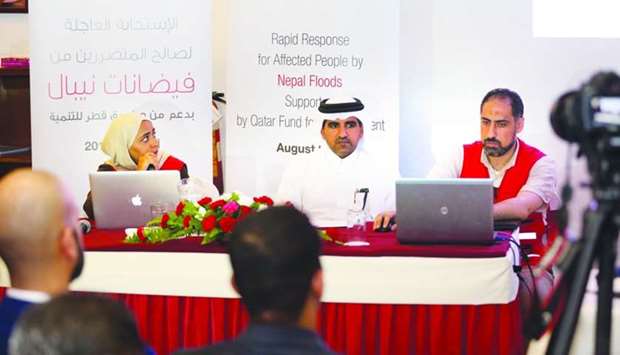The intervention was funded by Qatar Fund for Development (QFFD) and supervised by the Qatari embassy in Kathmandu, the capital of Nepal.
At a press conference held by Qatar’s ambassador to Nepal, Yousef Ahmed al-Hail, the QRCS team gave an overview of the organisation's humanitarian achievements in Nepal since 2013. The media was also informed about the details of the current relief intervention plan.
Until September 24, 1,298 affected families (6,490 people) received shelter and hygiene kits, including material such as mosquito nets, tarpaulins, soaps, washing powder, toothpaste, toothbrushes, hair shampoo and nail clippers, QRCS said in a press statement.
The distribution covered the most-affected families in the districts of Banke (Kathkuiya), Bardiya (Gulariya), Jhapa (Kamatoli), Morang and Sarlahi.
In the early days of the disaster, QRCS activated its Disaster Information Management Centre and allotted $240,000 for the initial intervention in emergency shelter, hygiene and health awareness for the benefit of 4,000 families (20,000 people).
Over 30 days, the team made field visits to assess needs and deliver aid in co-ordination with the Qatari embassy, Nepal Red Cross Society, the International Federation of the Red Cross and Red Crescent Societies, United Nations agencies, and the Health Services and Relief Association of Nepal.

Distribution of relief by QRCS

At the end of the mission, the QRCS team honoured al-Hail for his contributions to the success of the intervention. He was closely following up on the intervention plan, had appointed a team of the embassy staff to facilitate the mission and co-ordinated with the ministers of interior and foreign affairs.
The next phase of response would involve additional 2,700 families (13,500 people), the statement added.
During the 2013-2017 period, QRCS helped 90,850 families through disaster response, water, sanitation, healthcare and food security activities.
The worst since 2010, the floods of August 2017 caused serious landslides. According to preliminary reports, the disaster had a toll of 149 dead, 27 missing, dozens injured, 372,733 families affected, 92,216 families displaced, 64,997 houses destroyed and 144,973 houses damaged, QRCS said.
Blocked roads and toppled bridges hindered the evacuation of thousands of families and delivery of aid. There is also a high risk of malaria and other endemic diseases due to mosquitos, wet weather and large swampland areas.

The QRCS team gave an overview of the organisation's humanitarian achievements in Nepal since 2013, at a press conference held by Qatar’s ambassador to Nepal, Yousef Ahmed al-Hail.
Qatar Red Crescent Society (QRCS) has said its relief delegation to Nepal has completed the first phase of quick response to the recent floods and landslides in the country.


